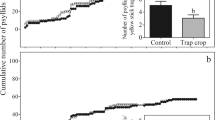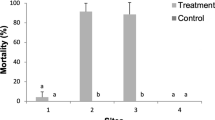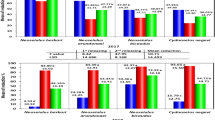Abstract
The predacious mite,Euseius addoensis addoensis (McMurtry) (Acari: Phytoseiidae), significantly (P<0.05) reduced scarring on ‘Palmer Navel’ oranges,Citrus sinensis (L.) Osbeck, caused by the citrus thrips,Scirtothrips aurantii Faure (Thysanoptera: Thripidae). A chemical exclusion method employing dicofol was used to determine the effect of the predator and numbers ofS. aurantii were monitored on sticky yellow traps. At two sites where numbers of citrus thrips and predacious mites were high, the percentage fruit culled from export quality due to damage byS. aurantii was reduced from 25.5 to 15.5% and from 32.7 to 18.7% by predacious mite activity.Euseius a. addoensis sometimes prevented damage from exceeding 1% cull and was most effective when mean numbers exceeded one mite per inside leaf at petal fall. The best correlation between numbers of mites and the percentage fruit culled at harvest was −0.96 at the location with the highest number of citrus thrips. Tartar emetic (0.398% a.i.) plus sugar (0.4% a.i.) treatments for citrus thrips were slightly detrimental toE. a. addoensis populations but their numbers soon recovered. An alternative treatment, methiocarb 0.016% a.i. plus sugar (0.4% a.i.), almost eliminated the predacious mites and resulted in more citrus thrips damage (10.7% cull) than in the adjacent untreated control (0.2% cull) which contained predacious mites.
Similar content being viewed by others
References
Congdon, B.D. and McMurtry, J.A., 1985. Biosystematics ofEuseius on California citrus and avocado with the description of a new species (Acari: Phytoseiidae). Int. J. Acarol., 11: 23–30.
Faure, J.C., 1929. The South African citrus thrips and five other new species ofScirtothrips Shull. Bulletin of the Faculty of Agriculture, Transvaal University College, 18: 1–18.
Grout, T.G., 1985. Binomial and sequential sampling ofEuseius tularensis (Acari: Phytoseiidae), a predator of citrus red mite (Acari: Tetranychidae) and citrus thrips (Thysanoptera: Thripidae). J. Econ. Entomol., 78: 567–570.
Grout, T.G. and Richards, G.I., 1990a. Monitoring citrus thrips,Scirtothrips aurantii Faure (Thysanoptera, Thripidae), with yellow card traps and the effect of latitude on treatment thresholds. J. Appl. Entomol., 109: 385–389.
Grout, T.G. and Richards, G.I., 1990b. The influence of windbreak species on citrus thrips (Thysanoptera: Thripidae) populations and their damage to South African citrus orchards. J. Entomol. Soc. South. Afr., 53: 151–157.
Grout, T.G. and Richards, G.I., 1991. Value of pheromone traps for predicting infestations of red scale,Aonidiella aurantii (Maskell) (Hom., Diaspididae), limited by natural enemy activity and insecticides used to control citrus thrips,Scirtothrips aurantii Faure (Thys., Thripidae). J. Appl. Entomol., 111: 20–27.
Kamburov, S.S., 1991. Damage to fruit and the impact on crop set from late infestations of citrus thrips (Scirtothrips aurantii). Citrus J., 1 (1): 33–34.
McMurtry, J.A., 1980. Biosystematics of three taxa in theAmblyseius finlandicus group from South Africa, with comparative life history studies (Acari: Phytoseiidae). Int. J. Acarol., 6: 147–156.
Morse, J.G. and Zareh, N., 1991. Pesticide-induced hormoligosis of citrus thrips (Thysanoptera: Thripidae) fecundity. J. Econ. Entomol., 84: 1169–1174.
Samways, M.J., Tate, B.A. and Murdoch, E., 1986. Monitoring the citrus thrips and psylla using fluorescent yellow sticky traps—a practical guide. Citrus Subtrop. Fruit J., 629: 9–15.
Schwartz, A., 1982. New predator of citrus thrip. Agric. News, 40: 6.
Steel, R.G.D. and Torrie, J.H., 1980. Principles and Procedures of Statistics. McGraw-Hill, New York, NY, 633 pp.
Tanigoshi, L.K., Fargerlund, J., Nishio-Wong, J.Y. and Griffiths, H.J., 1985. Biological control of citrus thripsScirtothrips citri (Thysanoptera: Thripidae) in Southern California citrus groves. Environ. Entomol., 14: 733–741.
Vermeulen, J.B., Sweet, S., Krause, M., Hollings, N. and Nel, A., 1990. A Guide to the Use of Pesticides and Fungicides in the Republic of South Africa, 34th edition (revised). Plant Protection Research Institute, Department of Agricultural Development, Republic of South Africa, 269 pp.
Wentzel, P.C., Georgala, M.B. and Bedford, E.C.G., 1978. Citrus thripsScirtothrips aurantii Faure. In: E.C.G. Bedford (Editor), Citrus Pests in the Republic of South Africa. Science Bulletin Department of Agricultural Technical Services, Republic of South Africa, 391: 137–141.
Wiesenborn, W.D. and Morse, J.G., 1986. Feeding rate ofScirtothrips citri (Moulton) (Thysanoptera: Thripidae) as influenced by life stage and temperature. Environ. Entomol., 15: 763–766.
Author information
Authors and Affiliations
Rights and permissions
About this article
Cite this article
Grout, T.G., Richards, G.I. Euseius addoensis addoensis, an effective predator of citrus thrips,Scirtothrips aurantii, in the eastern Cape Province of South Africa. Exp Appl Acarol 15, 1–13 (1992). https://doi.org/10.1007/BF01193963
Accepted:
Issue Date:
DOI: https://doi.org/10.1007/BF01193963




